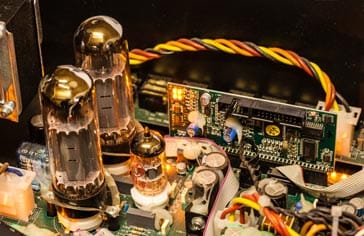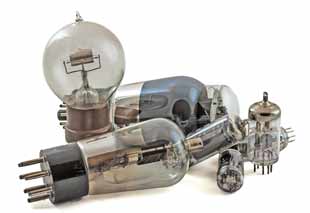How Does a Vacuum Tube Work
Two key concepts for understanding how a vacuum tube works are thermionic emission and charge attraction and repulsion.
Vacuum Tube / Thermionic Valves Includes:
Basics
How does a tube work
Vacuum tube electrodes
Diode valve / tube
Triode
Tetrode
Beam Tetrode
Pentode
Equivalents
Pin connections
Numbering systems
Valve sockets / bases
Travelling wave tube
The theory behind the operation of a vacuum tube is based on a concept known as thermionic emission which was noted soon after the invention of the incandescent light bulb.
In addition to this concepts including the attraction and repulsion of opposite and like charges play a large part in the operation of vacuum tubes / thermionic valves.
Understanding these concepts provides the basis behind understanding how a vacuum tube works. Although these electronic components may seem rather dated in todays semiconductor dominated world, these devices are sometimes still used and the technology can still be relevant in todays world.

Valves or tubes are still used in a number of electronic circuit designs. Valve amplifiers for audio are still preferred by soem audio enthusiasts and they are still used in a number of industrial applications as well as in a number of high power legacy broadcast transmitters.
Thermionic emission
The first concept needed to understand how a vacuum tube works is that of thermionic emission as this is at the heart of thermionic valve / vacuum tune technology.
Electrical conductivity of metals results from the fact that there are free electrons moving around the material and not attached to any definite molecule.
Although there are equivalent numbers of holes so that the overall charge remains balanced, these electrons roam freely around the material.
If these electrons are to leave the surface of the material, work needs to be done to overcome the attraction within the material.
The energy required to overcome the forces holding the electrons within the material can be supplied in a number of ways. One of these is to heat the material and in this way the electrons receive additional kinetic energy.
At a sufficiently high temperature, some electrons will have sufficient kinetic energy to escape from the surface of the material. This is thermionic emission of electrons, and it is this phenomenon that is at the core of how a vacuum tube works.

The process of thermionic emission from a material has many similarities with that of evaporation from the surface of a liquid. In the case of molecules in a liquid, the ones that escape and evaporate have sufficient energy to escape the retraining forces of the liquid, and the number escaping increases with increasing temperature.
It can be considered as essentially the same process in which the energy the electron must give up corresponds to the latent heat of vaporisation in a liquid.

Electron emission
In looking at how a vacuum tube works it is also necessary to consider the effectiveness of the way in which electrons escape from the surface.
The number of electrons emitted from the heated material per unit area is related to the absolute temperature as well as a constant 'b' that is a constant indicating the work an electron has to do to escape the surface.
As a result it is possible to derive an equation for the current leaving the surface:
Where:
I = current measured in Amperes
A = a constant for the type of emitting material
T= temperature in degrees Absolute
b = work required for electron to leave surface
Electron emitters - cathode materials
It is necessary to reach temperatures in excess of 500°C, dependent upon the material, for the number of electrons leaving the surface of the material to become appreciable. When working with temperatures of this order, it limits the materials that can be used on the cathodes of vacuum tubes.
There are a few favoured emitters that are used within vacuum tubes:
Tungsten: Tungsten provides one of the most robust forms of filament for a vacuum tube, particularly when very high anode voltages are used. However its drawback is that its emission efficiency expressed in terms of amperes emission per watt of heating is not as high as other emitters like thoriated tungsten and oxide coated emitters.
Thoriated tungsen: Thoriated tungsten is widely used in vacuum tubes and consists of tungsten containing 1 to 2% of thorium oxide. Vacuum tubes / thermionic valves using cathodes with this coating give electron emission at temperatures of between 1500° and 1600°K.
Vacuum tubes using thoriated tungsten must have a very high degree of vacuum otherwise the positive ions produced by ionisation of gases in the envelope will seriously affect the emission.
Oxide coated emitters: Vacuum tubes using this form of cathode coating have layer of a mixture of barium and strontium oxides coating the surface of the cathode. When properly activated they emit electrons profusely at a temperature of around 1100° to 1200°K. Oxide coated emitters are widely used because they give more emission per watt of heating than any other type.
One drawback is that the emitting surface is easily poisoned by impurities. Vacuum tubes using oxide coatings are used for most small vacuum tubes / thermionic valves using voltages up to a few thousand volts.
Although, normally vacuum tubes are indirectly heated these days, this form of heating is less efficient than the directly heated option. As a result, some specialist tubes or valves that use tungsten or thoriated tungsten filaments sometimes use direct heating techniques.

Space charge
One important aspect of vacuum tube theory is the space charge.
The electrons flowing between the cathode and the anode form a cloud of electrons and this is known as the "space charge". The space charge tends to repel electrons leaving the cathode, forcing them back. However if the potential applied to the anode is sufficiently high then the space charge effect will be overcome, so that electrons will flow toward the anode. In this way electrons are able to move across the vacuum within the glass envelope of the vacuum tube / valve, the circuit is completed and current flows.
As the potential is increased on the anode, so the current increases. Eventually a point is reached where the space change is completely neutralised and the maximum emission from the cathode is attained. The only way in which the electron emission fromt the cathode can be increased is by increasing the cathode temperature. This increases the energy of the electrons and as a result it allows further electrons to leave the cathode.
Although all areas of a vacuum tube have a space charge, it is of particular importance in the cathode region as it determines elements including the maximum emission.
As other electrodes are added into the evacuated envelope, the space charge concept can be applied to the whole operational area.
The space charge concept plays a crucial role in determining the flow of current in any thermionic device.
Child's Law
Child's Law, often also called the Child-Langmuir Law was first proposed in 1911 and it forms a key elements within thermionic valve or vacuum tube theory and how a vacuum tube works.
Child's Law states that the space-charge limited current in a plane-parallel vacuum diode varies directly as the three-halves power of the anode voltage and inversely as the square of the distance d separating the cathode and the anode.
Where:
J = current density in Amperes per metre squared,
Ia = anode current,
S = anode surface area in square metres
Child derived this equation applicable to vacuum tube theory in 1911 for the case of atomic ions. These have much smaller ratios of their charge to their mass. Irving Langmuir extended the basic law when he published the application to electron currents in 1913. This extended it to the case of cylindrical cathodes and anodes. It is for this reason that the law is sometimes referred to as the Child-Langmuir Law.
Vacuum tube / thermionic valve technology dominated electronics until the invention and later introduction of the transistor in the 1940s and 50s. It was really only in the 1960s that valve / tube technology started to be displaced. Even though valve / tube technology is not widely used these days, an understanding of how a valve / tube works can be very useful in a number of situations.
 Written by Ian Poole .
Written by Ian Poole .
Experienced electronics engineer and author.
More Electronic Components:
Batteries
Capacitors
Connectors
ADC
DAC
Diodes
FET
Inductors
Memory types
Phototransistor
Quartz crystals
Relays
Resistors
RF connectors
Switches
Surface mount technology
Thyristor
Transformers
Transistor
Unijunction
Valves / Tubes
Return to Components menu . . .




